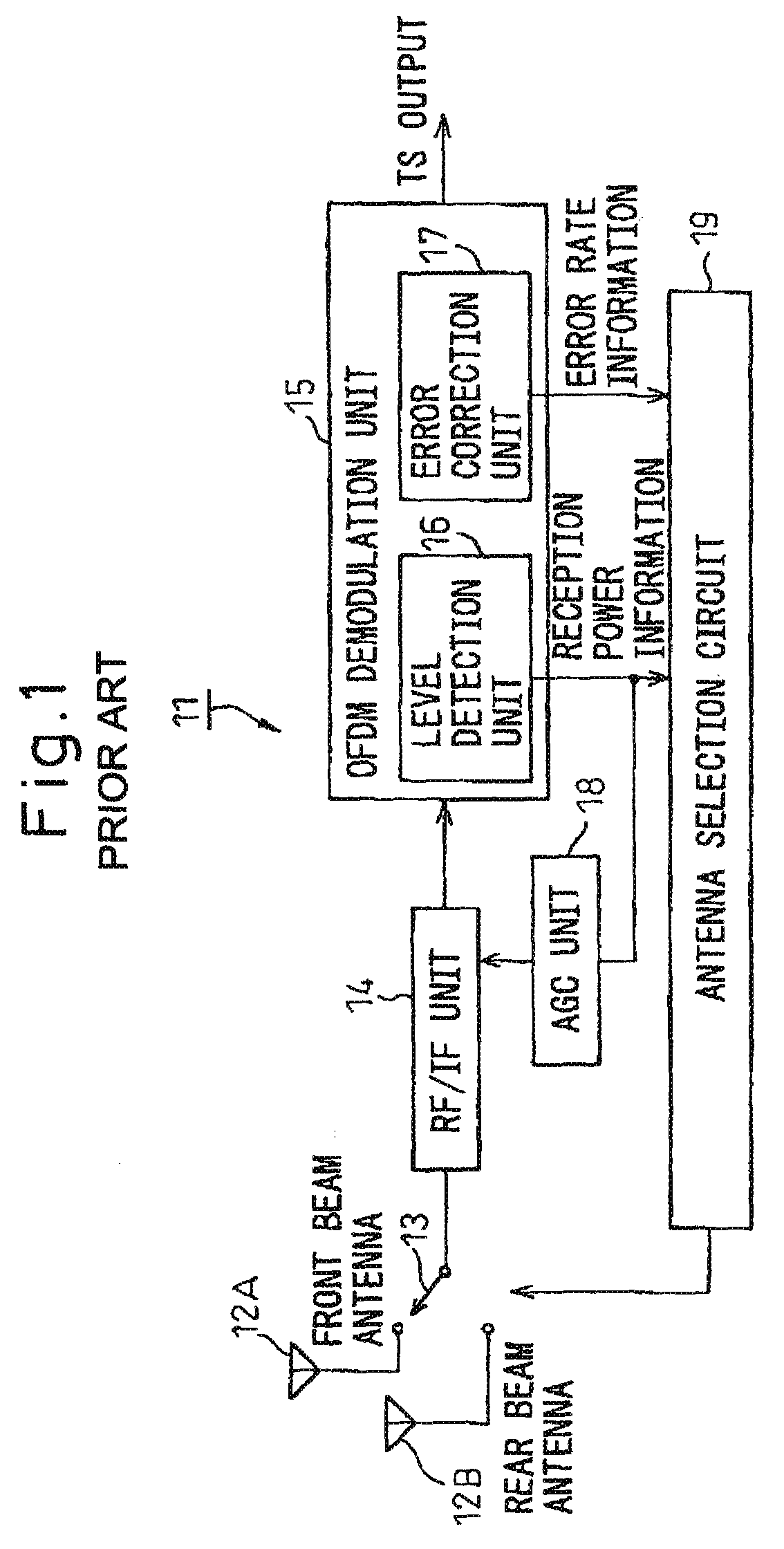Receiver
a receiver and receiver technology, applied in the field of receivers, can solve the problems of degrading the degrading the line quality of broadband wireless communication, and already changing the reception environment of the radio wave, so as to achieve the effect of good reception state and degrading the reception sta
- Summary
- Abstract
- Description
- Claims
- Application Information
AI Technical Summary
Benefits of technology
Problems solved by technology
Method used
Image
Examples
second embodiment
[0107]FIG. 9 shows the present invention.
[0108]In this example, first, the tuner 1 side (system 1 side) is switched to the front beam antenna FR (21A), and the tuner 2 side (system 2 side) is switched to the rear beam antenna RL (22B) (S0202 and S0203).
[0109]In this state, the tuners 1 and 2 (24-1 and 24-2) detect the states of reception (S0202 and S0204) and compare the states of reception (S0205). If the reception level of the tuner 1 is larger than the reception level of the tuner 2 (tuner 1>tuner 2), it is judged that the radio wave is being received from the front of the vehicle, and the front beam antenna FR (21A) of the tuner 1 side and the front beam antenna FL (22A) of the tuner 2 side are switched to (S0206).
[0110]Conversely, if the reception level of the tuner 1 is smaller than the reception level of the tuner 2 (tuner 12), it is judged that the radio wave is being received from the rear of the vehicle, and the rear beam antenna RR (21S) of the tuner 1 side and the rear b...
third embodiment
[0112]FIG. 10 shows the present invention.
[0113]In this example, first, the tuner 1 side (system 1 side) is switched to the front beam antenna FR (21A), and the tuner 2 side (system 2 side) is switched to the front beam antenna FL (22A) in the same way as the above (S0301).
[0114]In this state, the tuners 1 and 2 (24-1 and 24-2) detect the reception levels (S0302). In this example, when the radio wave from the front of the vehicle exceeds a predetermined reference value, the state of reception thereof is maintained (S0303 and S0304), while conversely, when it is the reference value or less, the tuner 1 side is switched to the rear beam antenna RR (21B) and the tuner 2 side is switched to the rear beam antenna RL (22B) (S0305).
[0115]In this example, both of the systems 1 and 2 detect the states of reception by using directional antennas of the same orientation, therefore there is the advantage that frequency division diversity can be used even while moving at a high speed. Due to this...
fifth embodiment
[0122]FIG. 12 shows the present invention.
[0123]This example is a modification of the third embodiment shown in FIG. 10, but further is predicated on the reception environment of FIG. 11. Accordingly, steps 50501 to S0503 of this example are the same as S0401 to S0403 of FIG. 9, so no further explanation is given here.
[0124]In this example, when detecting deterioration of reception (S0503), the tuner 1 side (system 1 side) is switched to the front beam antenna FR (21A) and the tuner 2 side (system 2 side) is switched to the front beam antenna FL (22A) in the same way as the above (S0504).
[0125]In this state, the tuners 1 and 2 (24-1 and 24-2) detect the states of reception (S0505). Here, the overall reception level detected at the tuner 1 and the tuner 2 (S0505) and the state of reception before the start of the present control (S0502) are compared (S0506). As a result, if the difference of the reception levels of the two is smaller than a predetermined reference value, it is judged...
PUM
 Login to View More
Login to View More Abstract
Description
Claims
Application Information
 Login to View More
Login to View More - R&D
- Intellectual Property
- Life Sciences
- Materials
- Tech Scout
- Unparalleled Data Quality
- Higher Quality Content
- 60% Fewer Hallucinations
Browse by: Latest US Patents, China's latest patents, Technical Efficacy Thesaurus, Application Domain, Technology Topic, Popular Technical Reports.
© 2025 PatSnap. All rights reserved.Legal|Privacy policy|Modern Slavery Act Transparency Statement|Sitemap|About US| Contact US: help@patsnap.com



